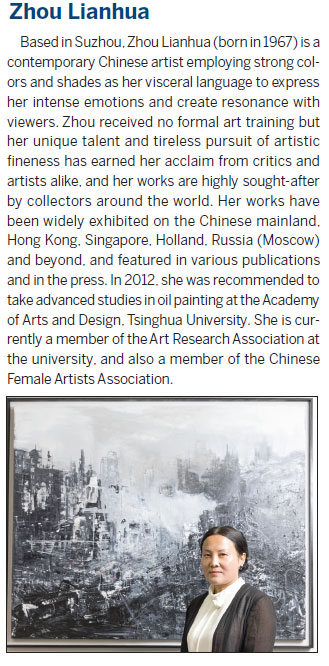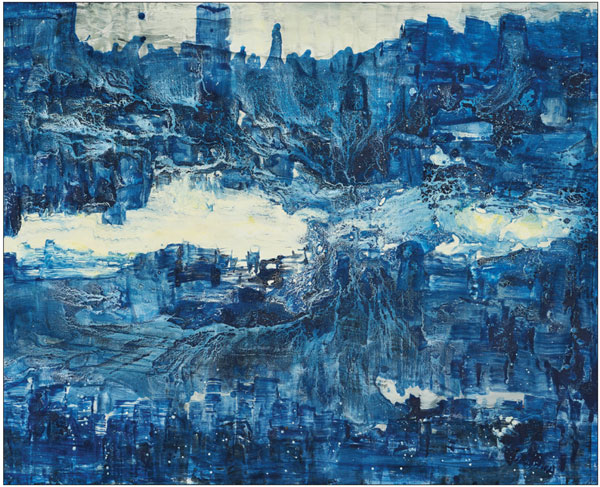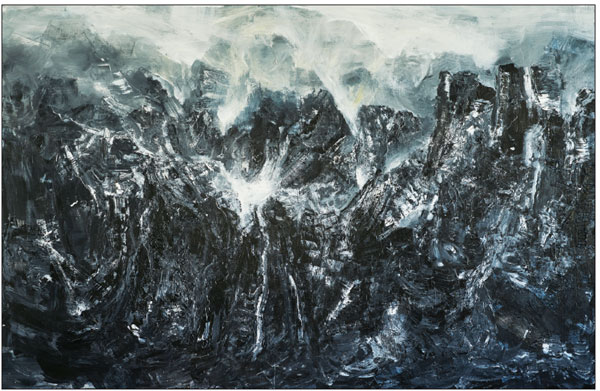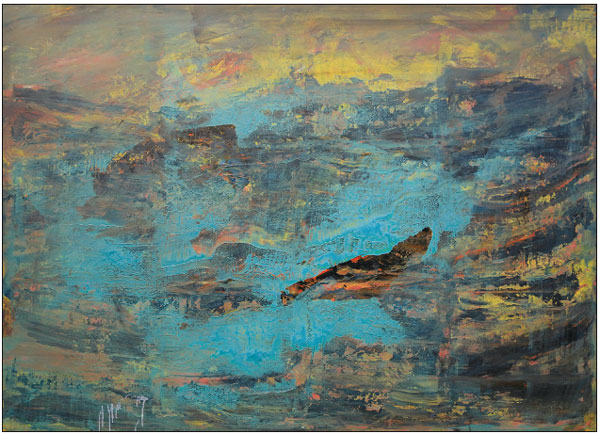A brush with the Chinese Dream
Updated: 2017-09-29 06:37
(HK Edition)
|
|||||||||
Zhou Lianhua started painting around 18 years ago at night time as a self-imposed therapy to help her deal with the strong emotion of bereavement over the sudden death of her husband. To help her overcome her grief and to deal with the burden of being sole provider for her three young children, Zhou started occupying herself doing things that could lift her spirit. So she turned to painting.
Zhou's art represents a story of her organic reactions to the influx of intense emotions of personal experiences, and the contemplation of their relation to the world around her. Her paintings are a form of dialogue with her own thought processes. Zhou presents each scene and chapter of each story in varied combinations of colors and shades. Each color represents an emotion with myriad shades representing the varied degrees of intensity of that emotion. The result is something powerful and poetic. Created with pure emotion, they also touch the viewer's heart.
With the cathartic healing process of art, Zhou apparently has not merely indulged in her own melancholy, but also has turned her attention to broader social issues in her work. But her current art is no less visceral, no less emotional. Zhou is no longer a struggling single parent but, still wielding first-hand knowledge of the affecting power of art, is now a visionary artist who uses her art in order to engage the public, encouraging dialogue in social issues that matter to her.
The Hong Kong-based Gallery of Contemporary Arts (GOCA), which has been working with Zhou for the past two years, coined a new term, Purposive Art, for Zhou's new collection titled "China Dream". Purposive Art is art created for the special purpose of engaging the public to reflect on current issues, with the intention of igniting intellectual thinking and dialogue. Dismissing the idea of "art for art's sake", Zhou is comfortable wielding her brush as a tool of discursive engagement. "If art were to come to being without content or meaning behind it, it could never have been brought into being. When we look at a child scribbling, the scribble has meaning to the child," Zhou said. She sees art as having the potential to inspire and move individuals to be more thoughtful of transcendental values and be better people.

The collection "China Dream" is Zhou's interpretation of President Xi Jinping's "Chinese Dream" - a set of personal and national ideals to revitalize the nation. Zhou's collection is an examination of art as a stimulus for reflection on social and civic matters. More specifically, Zhou sees any effective participation in social matters as necessitating the cultivation of the self. To Zhou, that means a return to the spiritual humanism of old Chinese philosophy, such as the one expounded in the chapter of Li Ren in the Analects of Confucius:
The Master said, "When we see men of worth, we should think of equaling them; when we see men of a contrary character, we should turn inwards and examine ourselves." Only a constant self-reflection can cultivate better individuals - individuals that in turn can make a difference in society.
The painting Blue Sky White Cloud from Zhou's "China Dream" collection, to be offered at China Guardian (Hong Kong) Auctions (Sept 30 to Oct 3), is an exemplary embodiment of Zhou's vision. The image in the painting attempts to capture the beauty and harmony of a society that functions through humanistic values rather than monetary values. The "Dream" in this instance is conserving a world that is not polluted for future generations.
The Chinese Dream looks to the future, but acknowledges the past and present. The new narrative of the country is to be written by integrating the old traditions, values and culture with new wisdom and knowledge. Only then will any sort of economic growth or national development be sustainable, and China's soft power and cultural influence be able to steadily develop. Essentially, President Xi's aim is a reinstatement of the Chinese civilization as a major cultural influence - a revitalized center of the philosophical tradition of humanism and spiritualism for global benefit. To achieve this will require a comprehensive strategy for cultivating talent and wisdom not only in science and technology but also in philosophy, the arts and culture.
Zhou dipped into this integration of old and new in her previous collection, "A Dialogue with Mencius", which was displayed at Art Central Hong Kong in March. The central theme focused on the missing elements of modern society that make people susceptible to pollution, corruption and shallowness, and the reintroduction of traditional culture, history and values as a cure.
The collection "A Dialogue with Mencius" documents the artist's impressions of the transformation of China over the past 30 years. It presents the grittiness and philistinism of city scenes, in contrast with the tranquil landscapes of traditional Chinese paintings. Zhou's narratives are provocative and make viewers think of questions such as: What is modernity and development? What have we lost? What have we gained? The general atmosphere of Zhou's paintings in this collection is a nostalgic hankering for a type of Confucian humanism-the self-awareness, respect, and consideration of others that can bring peace alongside the hustle of modernity.
"It is important for Chinese to retrieve their cultural heritage, in particular, to restore those traditional emphases on self-cultivation which includes the cultivation of empathy, the cultivation of knowledge and wisdom, and the cultivation of the spirit of rightness that moves us to take appropriate action," said Zhou. She believes this is the real power that can take humanity forward into the next century and resolve many of the ailments of post-modernity. It is a hopeful movement to see a Blue Sky and White Cloud emerge from the smog, heralding the new China.




(HK Edition 09/29/2017 page16)